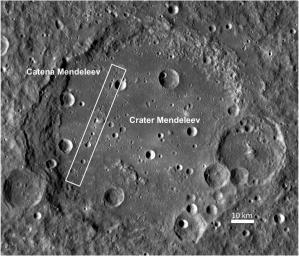
|
Crater Mendeleev
- Click the image above for a larger view
- Full-Res JPEG (1318 x 1127) (271.1 kB)
- Full-Res TIFF (1318 x 1127) (1.5 MB)
Caption:
The LROC WAC 100 meters/pixel monochrome mosaic shows the entire Crater Mendeleev (313 kilometers in diameter). The white box marks the location of Catena Mendeleev.
Mendeleev crater (named after Dimitri Mendeleev, the inventor of the periodic table of elements) is a very large, Nectarian-age crater on the lunar farside (5.7°N, 140.9°E). Approximately 313 kilometers in diameter, it is almost large enough to be a small basin. The interior contains many younger craters, including Catena Mendeleev, but also features a very smooth floor filled in with a light plains material. In general, this material is characterized by its smooth surface and intermediate albedo (brighter than basaltic mare material, but not as bright as highlands material). Light plains are found elsewhere on the Moon, most notably in the Cayley formation, the Apollo 16 landing site. Light plains are usually thought to be emplaced as large scale grounding flows of ejecta from large basin forming impacts. However details of this formation mechanism are still not well understood.
Background Info:
NASA's Goddard Space Flight Center built and manages the mission for the Exploration Systems Mission Directorate at NASA Headquarters in Washington. The Lunar Reconnaissance Orbiter Camera was designed to acquire data for landing site certification and to conduct polar illumination studies and global mapping. Operated by Arizona State University, LROC consists of a pair of narrow-angle cameras (NAC) and a single wide-angle camera (WAC). The mission is expected to return over 70 terabytes of image data.
Cataloging Keywords:
| Name | Value | Additional Values |
|---|---|---|
| Target | Moon | |
| System | Earth | |
| Target Type | Satellite | |
| Mission | Lunar Reconnaissance Orbiter (LRO) | |
| Instrument Host | Lunar Reconnaissance Orbiter | |
| Host Type | Orbiter | |
| Instrument | Lunar Reconnaissance Orbiter Camera (WAC) | |
| Detector | Narrow Angle Camera (NAC), Wide Angle Camera (WAC) | |
| Extra Keywords | Crater, Grayscale, Impact | |
| Acquisition Date | ||
| Release Date | 2011-02-04 | |
| Date in Caption | ||
| Image Credit | NASA/GSFC/Arizona State University | |
| Source | photojournal.jpl.nasa.gov/catalog/PIA14002 | |
| Identifier | PIA14002 | |
